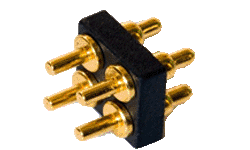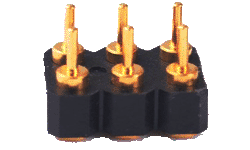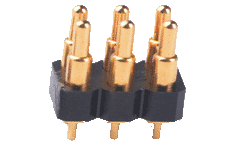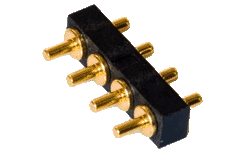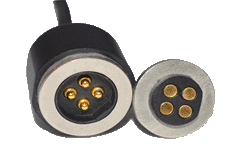2022-6-28 8:50:11
Why the pogo pin need to gold plating?
Gold plating, is a kind of decorative technology, is also one of the commonly used words. It originally referred to coating the surface of an object with a thin layer of gold. Later, it is also used to describe people who go to a certain environment for further study or exercise just to gain a false reputation.
Gold-plated standard:
The gold plating of Pogo Pin is mainly for conducting electricity. The grade of the gold coating is converted according to the gold content in the coating, and pure gold is represented by 24K. For example, the gold content of 18K gold is 100g×18/24=75g. Therefore, K gold and gold content is as follows:
14K gold 54.2-62.5%;
16K gold 62.6-70.8%;
18K gold 70.9%-79.2%;
20K gold 79.3-87.5%;
22K gold 87.6-95.9%;
24K gold 95.9% or more.
The quality of gold plating is based on the thickness of the gold plating layer, gloss gloss. The standard of gold jewelry commonly used internationally is; The coating thickness of good gold-plated jewelry is 10-25 microns, and the coating thickness of general gold-plated jewelry is 2-3 microns. If the coating of jewelry is below 0.18 microns, it can not be called "gold-plated" but called "gold-coated", which belongs to the cheap jewelry process
Gold-plated characteristics:
The gold-plated layer is golden yellow in appearance, with high chemical stability, only soluble in aqua regia and other super acids, insoluble in other acids. The atomic valence of gold is one and three. The standard potential φ°Au+/Au of monovalent gold is +1.68V, and that of trivalent gold is +1.50V. For steel, copper, silver and their alloy substrates, the gold coating is negative, and the porosity of the coating affects its protective performance.
The gold plating layer has good ductility, easy polishing, high temperature resistance and excellent resistance to discoloration. Gilding the silver prevents discoloration; Gold alloy coating can present a variety of colors, so it is often used as decorative coating, such as plating jewelry, clock parts, art, etc.
Gold plating has low contact resistance, good electrical conductivity, easy to weld, strong corrosion resistance, and has a certain wear resistance (refers to hard gold), so it has a wide range of applications in precision instruments, printed circuit boards, integrated circuits, shells, electrical contacts and so on.
Chemical gold plating and electric gold plating:
The advantage of chemical gold plating is that the part to be plated does not need electrical connection, uniform coating, more suitable for surface mount. The disadvantage is that the solution is difficult to maintain, and the chemical nickel used in the base should be washed regularly to wash the nickel on the surface of the tank, which causes the discontinuity of production. Running costs are also higher. The hardness and wear resistance of chemical gold plating layer are worse than that of electroplating hard gold, and the thickness can be limited, so it is not suitable for some surface mount welding methods. In order to make up for this shortcoming, chemical nickel palladium plating is also used instead of chemical nickel gold, which is suitable for various welding methods of surface mount.
Electroplating has opposite advantages and disadvantages. The hardness and wear resistance of electroplating (hard gold) is better than that of chemical gold plating, the solution is easy to maintain, no need for washing tank, can be suitable for various welding methods of surface mount. The main disadvantage is that the thickness is not uniform, the part to be plated requires electrical connection.
Chemical gold and electrogold have different uses, depending on which customers are served
Gold plating liquid:
Gold plating presses its craft characteristic, have cyanide gold plating and have cyanide gold plating two kinds. Cyanidation bath is divided into high cyanide and low cyanide bath. Sulfite plating solution is widely used in non - cyanide plating solution.
Gold plating solution according to its concentration, there is water plating gold solution is generally acidic, the gold content is low, up to 0.4 ~ 0.5g/L. The cost of this bath is low, so the loss of the solution is less. The plating solution of the gold layer color is green gold, especially suitable for large quantities of plating, and low processing costs, and gold plating hardware, such as buttons, belt buckles and so on.
Gold plating liquid
According to the function of gilding fluid, pre-gilding refers to pre-gilding in a specific gilding fluid before the normal gilding process and then into the normal gilding process. There are several advantages of gold-plating after pre-gold-plating treatment:
1) Ensure the binding force of gold plating.
2) Reduce the possibility of contamination of positive gold-plated grooves.
3) Economical and practical, cost reduction.
4) It can improve the density of the gold-plated layer.
The so-called pure gold plating, that is, the gold coating can not contain other metal components. Therefore, various metal salts can not be used as additives to achieve certain functions in the electroplating process. But pure gold coating soft, good ductility, not wear. Wear-resisting gold plating is to improve the hardness of the gold layer. To meet the functional requirements of some electronic components, improve wear resistance. In order to obtain a coating with good wear resistance, cobalt salt, nickel salt and other additives are generally added to an acid gold-plating solution to deposit a gold alloy coating containing certain cobalt or nickel components, so as to achieve the purpose of improving wear resistance.
Gold plating liquid according to the color, commonly used rose gold is gold copper alloy containing 85% gold, it has high wear resistance and chemical stability, not easy to change color. The bath is mainly composed of complexing agent, gold salt and copper salt.
Decorative gold alloy is mainly used in jewelry for many, in order to get a bright, clear, let a person like the color. Such as gold - nickel alloy, gold - indium alloy, gold - copper alloy, gold - silver alloy. Most of the gold alloy color is golden series, such as gold, light gold, rose gold. Another color is slant red department, such as peach, pink, rose. Gold and silver alloys can also be obtained with a green coating. Partial colors can also be obtained in gold-nickel and gold-silver alloys. Since gold is very expensive, it is impossible to do experiments to choose colors. There are some formulas in the manual for reference, and potion vendors also have goods to choose from.
The quality of gold plating is cyanide (potassium) gold plating is better, its color, adhesion, wear resistance is better than gold plating without cyanide. In recent years, with the progress of electroplating technology, the gold-plating technology has a new breakthrough, in the past, there is only one kind of gold-plated jewelry yellow gold. French, American, Japanese gold jewelry has three colors, or even more colors. The colored gold plating, known as tricolor gold, comes in rose, silver, gold, black and blue. In general, homogeneous plated plating does not need to be too thick, as long as it reaches 2 microns on the ok. The plating of heterogeneous gold plating should be thicker. Some countries stipulate, the coating of gilt of this kind of product must achieve 10 micron above, if the famous Johnson & Johnson mai that Britain is famous, limited company achieves 12.5 micron to the plating requirement of gilt, just is qualified.


